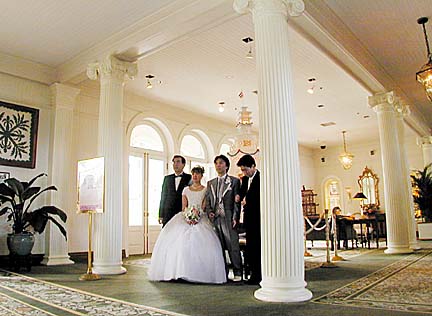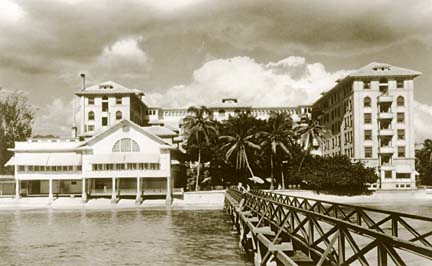Advertisement - Click to support our sponsors.


WHAT a view Moana hotel creator Walter Peacock must have had! Architect O.G. Traphagen's design for the Moana Hotel in Waikiki, a soaring Victorian fairy-tale structure that floats like a dream on the cusp of Waikiki Beach, had Peacock's office tacked on top, like the flying bridge of a battleship.
The Sheraton Moana
Surfrider celebrates
100 years of alohaBy Burl Burlingame
Star-BulletinIt was six floors up in what was a two-story community, completely surrounded by arched windows. To get there, he installed the first electrical elevator in the Territory of Hawaii.
To the east, Peacock looked directly at Diamond Head; to the north, into the shifting mists of Manoa Valley; to the west, the curving haunches of the Waianaes as they tumbled into Ewa; to the south, the boundless blue of the Pacific.

No wonder, points out tour guide Tony Bissen gamely, Peacock never got any work done.Bissen is leading a group of tourists and local folks through the hotel in his twice-daily ritual of a historic tour of the elegant building, which turns a century old this weekend. In the lobby, a digital countdown clock races through the tenth-seconds, seconds, minutes, hours and days until the anniversary. The red numbers are whizzing. "It seems to be going faster every day as we get closer," said Moana PR director Erica Neves. "That's not possible, is it?"
Unlike many older structures that have been so modified over the years that their original personality is lost -- see the story on The Queen's Hospital (Wat Dat? on D-1) -- the Moana has been constantly tinkered with and still retains its original purity of design. The primary architectural change was the addition of concrete wings in 1918 on either side of Traphagen's wooden centerpiece, which had enclosed widow's walks added along the roof peaks adjoining the architect's skyview office.

Other changes included efforts to "modernize" the decor, going Art Deco in the '30s and Bauhaus in the '50s, wouldn't you know.The hotel was fading gracefully as part of the Sheraton Moana Surfrider cluster when owners Kyo-ya Company decided to sink $50 million into the structure a little more than a decade ago, not to update, but to backdate. The hotel was time-tunnelled back to 1901, or at least as near modern visitor conveniences would allow.
The renovation not only preserved the building, it was a canny marketing move. Moana advertising contains lines like: "This is how a century of travelers remember Waikiki" and "A valentine from the Victorian era in the heart of Waikiki." It is also a recognition that tourism has its own developing history and culture, and that successful hotels reflect their unique surroundings.

Since the renovation and restoration -- it was a little of both -- the Moana has won a pile of historic preservations awards, including the prestigious President's Historic Preservation Award, which noted that the hotel "evokes its own and its island setting's proud heritage eloquently." The principal restoration architect was Virginia D. Murison of Honolulu.The revamped hotel included a bright idea catching on at other resorts, a "historical room" of exhibitry presenting the Moana's service-industry past as part of a cultural heritage. At the Moana, the room is on the second-floor lobby and includes display cases containing artifacts such as bulky wool Moana swimsuits, colorful Moana postcards, Moana sheet music, photographs and other mementoes of time gone by.
Artifacts such as the primary chandelier in the lobby were discovered in storage at the Royal Hawaiian. Other things just come in. Neves said someone returned a 1920s Moana room key the other day. "Must have been on their conscience!" she laughed.

The exhibit was designed by DeSoto Brown, Jodi Belknap and Gene Kois."It's a very nice amenity that's enjoyed not just by guests but others as well," said Brown, a collector of Hawaiian ephemera and archivist at Bishop Museum. "In fact, I'm told that the bulk of visitors are from off the street! This is unique because the average hotel doesn't have enough history to warrant such an exhibit, but the Moana was the first serious hotel in Waikiki."
"The historic aspects of the hotel are a real selling point," said Neves, watching a Japanese couple in formal wedding attire having their picture taken in front of a gigantic 100th birthday cake in the lobby.
"Japanese visitors, particularly newlyweds such as these, are taken with the history and elegance. They may get married at little chapels all over the island, but they all stay here!"
Bissen's flock of curious visitors follow him around the hotel as he points out items of interest. He's friendly and engaging and has been doing this for a decade.
The hallways are extra wide to accommodate steamer trunks -- such a trunk is on display in the historical room -- and the rooms still have high ceilings, transom fittings over the doors and cross-ventilation windows to cool the structure in pre-airconditioning days.

"And look at some of the windows -- see the wavy pattern in the glass? Original glass from 1901," said Bissen. At the very apex of the building, up in what had been Peacock's office, there are a lot of windows indeed and a splendid view of Kalakaua Avenue.Even an average room is interesting, and Bissen finds one that is empty. "I'm at the mercy of occupancy!" he mock-complains.
A couple of dozen people crowd into the room, and he points at an enormous armoire. "The original rooms had these and they're a nice touch, but we had to get more for the restoration. Now they hold the TV set and the refrigerator to hold your goodies from the ABC store -- that stands for All Blocks Covered! -- and notice the wood. It's cherry!"
Traphagen decided on a wood motif for each floor. The first floor is oak, the second floor is mahogany, third is maple, fourth is koa and fifth is cherry.

The Moana may have been built in 1901, but it's a 2001 hotel. Bissen points out a tiny motion detector placed high on the wall. "That turns the lights on if any motion is detected in the room, and turns off the lights if nothing is detected. The first year we had that in place, we saved $168,000 in electrical costs."At each end of the widow's walks, where the roofline joins the 1918 annexes, are the hotel's notorious "crooked" rooms, alcoves in which the walls lean drunkenly toward the building's center of gravity. Each room on opposite sides of the building are mirror images of each other.
"We're still not sure what happened here, but there was some sort of problem or miscalculation where the room joined the corner truss. It had to be reinforced with steel beams. Looks like you've had too many Mai Tais, yeah?"
This weekend marks the Moana Hotel's 100th birthday. In addition to decorations and exhibits already on display at the historic structure, celebratory events include: Birthday events
Friday evening: A Grand Anniversary Celebration. A cocktail reception runs 5 to 7 p.m., followed by a two hour show featuring Jeffrey Apaka, Nina Kealiiwahamana and Bill Kaiwa, along with guest artists including Bev Noa, Halau Hula Olana, Joe Recca and the Mark Yim Quartet. All are veterans of the famous "Hawaii Calls" radio show that originated from the Moana. Admission is $100 and includes pupu and cocktails. Information and reservations: 922-3111.
March 10: Edgy Lee's documentary "Waikiki" will premiere, and closed-circuit televisions will carry the film around the hotel's Banyan Courtyard. The hotel is also offering classic-film retrospective series twice a month, starting in late March. Commentary will be provided by film collector Steven Frederick. Information and reservations: 922-3111.
March 11: There will be a Centennial Anniversary Brunch running 9 a.m. to 2 p.m. to mark the actual anniversary of the hotel's original opening day. Information and reservations: 922-3111.
The hotel offers free historical tours of the building at 11 a.m. and 5 p.m. Monday through Friday. More information is available at http://www.sheratonhawaii.com.
Click for online
calendars and events.